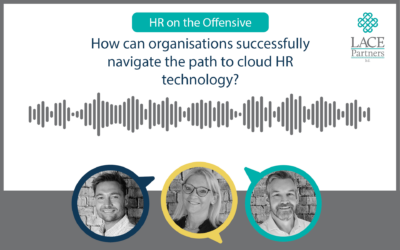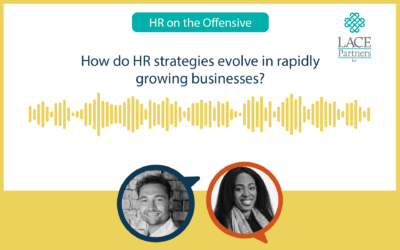In the second of a two-part HR on the Offensive podcast with our partners Norton Rose Fulbright (you can read part one here), we discussed the issues of furlough and redundancy for HR teams and the businesses they operate within. Once again Cathy and Chris from LACE Partners spoke to Paul Griffin, Head of Employment at Norton Rose Fulbright, to discuss key questions that many HR directors are asking, especially given the recent government announcements about extending the Coronavirus Job Retention Scheme to October this year. Below we’ve set out some of the key questions.
What can I ask my employees to do while on furlough without jeopardising our claim from the Coronavirus Job Retention Scheme?
The first key point in answering this question is in relation to whether the employee is providing any services to their employer, or even a company linked to their employer, because the employee cannot provide services to their employer when they are furloughed. If an employee is on the Job Retention Scheme (“furloughed”) they can volunteer or work with another organisation not linked to their employer but they cannot be asked by their employer to provide any services. The government guidance states that the worker can undertake training, although the employer will be required to pay National Minimum Wage whilst undertaking the training.
There is also the issue of meetings that happen within the organisation. For example company-wide meetings that take place; in this instance employers should take a ‘passive’ approach and not make any meetings compulsory, to avoid the risk of being seen to be ‘crossing the line’ in terms of what the employee is reasonably expected to do whilst on furlough.
What if you are ‘topping up’ an employees salary? Can you request that they undertake additional work?
Realistically that isn’t the best position to put yourself in as an employer. As part of the furlough scheme you have to make a declaration to HMRC that you have not required employees to work during the period the employee was on furlough, so to request that they do complete work whilst on furlough puts you in to a compromising position.
It is a challenging situation because during this difficult time an employer may find themselves looking to undertake a collective consultation pursuant to a redundancy process and so there is a fine line to tread between trying to keep employees engaged and keeping them informed in relation to essential communications which form part of the consultation. As with some of the advice in the previous blog the communication to your employees, and being clear in the arrangements for furlough, is vital to ensure that you can have a smooth transition back to work, or when you need to start going through the redundancy consultation process that employees make themselves available.
What are the legal considerations I need to take/questions I should be asking when thinking about bring people back from furlough?
The decision to bring people back should be based on objective business need principles. Differentiation shouldn’t be on the basis of any protected characteristics , for example, selecting people based on their childcare arrangements, or people that are not pregnant or shielding. If you clearly anchor the reason for returning specific workers to business needs then that would be the best approach.
As an example, if you have a business where you have 100 workers who all undertake a similar job and up until now your business hasn’t been able to operate, but now you are able to bring back workers in a piecemeal fashion – how do you decide?
All employees who can continue to work from home should, adhering to government guidance. In addition health and safety risk assessments will need to be completed. After that consideration as to who could return to work could be firstly on a voluntary basis, but then if you don’t get the response you need you should consult with employees. Employers will find that many employees simply cannot work for personal reasons, so bringing out those issues as soon as possible is essential to ensure any smooth transition for the workforce returning.
There is certainly no ‘one size fits all’ approach. Understanding the individual circumstances of employees will be critical not just at this time, but also so that when everyone is back to normal in terms of working patterns, you can help to support employees even after the furlough period has ended.
What about part-time working from July? What are the logistics of that (contracts, hours, etc)?
The furlough scheme does not regulate employment relationships. But in terms of getting your employees to agree to enter the scheme and act in a way that will make the scheme work for the employer is about the employment relationship and therefore employment law. That agreement must be made between the employer and the employee. Employers cannot simply state that an employee goes back to work part time if their original contract was subject to different working arrangements (length of time worked, etc).
Once again, the key with this is effective communication and giving employees as much notice as possible to return, although there is nothing specified in terms of giving a set amount of time to return to work for the furlough scheme.
What are the rules surrounding holiday for furloughed workers during this period?
Employees must be paid full pay if they book holiday when they are furloughed. It will be difficult for some employers to pay full pay during that period and there are provisions in the working time regulations which allow employers to stipulate when holiday must be taken. The employer does have control over the holiday and if an employer is going to cancel a holiday they must give adequate notice i.e. if an employee requests a two week’s holiday then two weeks’ notice must be given if the holiday is going to be cancelled.
The big challenge may be employees taking a large chunk of holiday when people return from furlough. From a business perspective if the business does start to pick up when things return back to normal, what a business cannot afford is to have large numbers of employees on holiday.
It is important to note that statutory holiday obligations have also changed. There is the ability for a carry over of four weeks for a two-year period where it is not reasonably practicable for employees to take it. An example could be that it is not reasonably practicable for an employee to take holiday during furlough because an employer cannot afford to pay the employee.
Are there any Covid-19 considerations I need to make when potentially selecting individuals for redundancy?
Choosing employees for redundancy from a pool of employees must be undertaken according to objective, fair and non-discriminatory criteria. Using any Covid-19 factor is likely to be discriminatory, for example through disability, and with the potential long-lasting effects of Covid-19 a consideration, this may also be considered a disability for the purposes of the Equality Act.
If the individual cannot return to work because they are pregnant, or for example they are in BAME category, or are shielding somebody then there might be a grounds for discrimination if the employer targets them for redundancy. If an employee does not want to return to work because they perceive an imminent danger in the workplace and they are subsequently one of the people placed for redundancy, they may be able to make a claim that they were unfairly dismissed. As an employer you would need to be very careful about the decisions you make when selecting for redundancy. It is therefore more important than ever to ensure that your selection choices for redundancy are fair and non-discriminatory.
Do I need to make furloughed employees redundant first?
That may not necessarily be the case. Furloughed workers are in that position due to a temporary change in the businesses situation. However when a business reviews its objectives and strategy post-Covid-19, it may be a longer term decision that parts of a business are no longer viable. It is important to understand that in relation to redundancy an employment tribunal will not generally look behind businesses decisions regarding the need for redundancies and they will be free to implement redundancies provided that the decision on redundancy is implemented fairly and in a non-discriminatory way.
If you would like to find out more about your duty of care, or if you would like to talk to the team at Norton Rose Fulbright about your specific circumstances, get in touch with Paul via LinkedIn, or reach out to him at Paul.Griffin@nortonrosefulbright.com.






